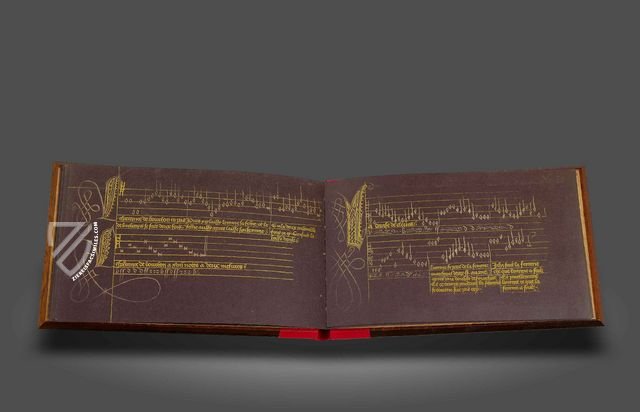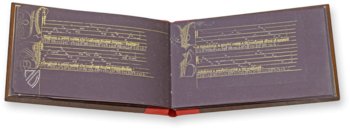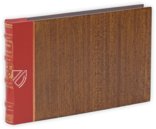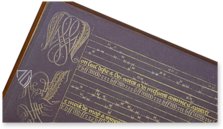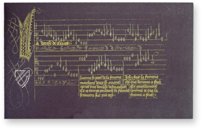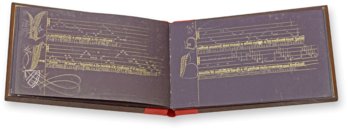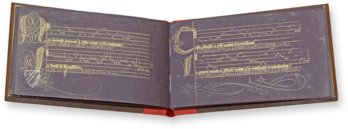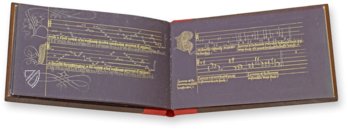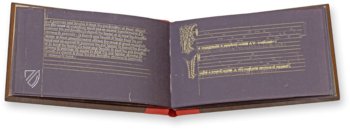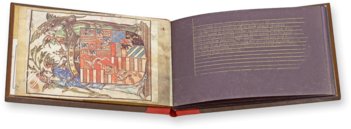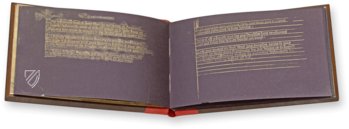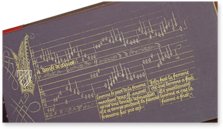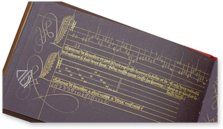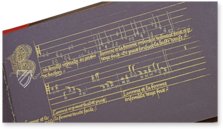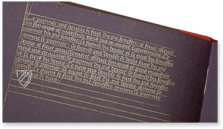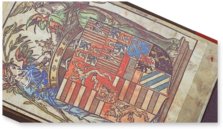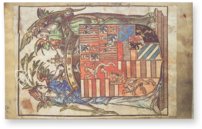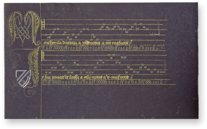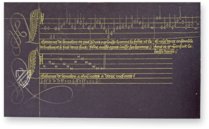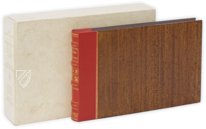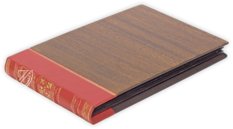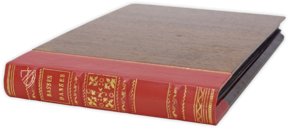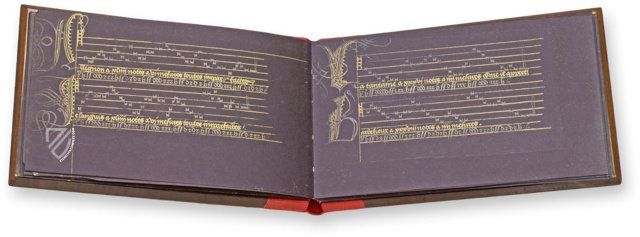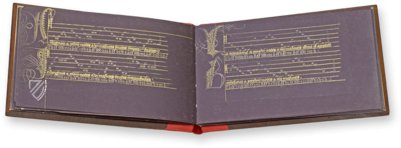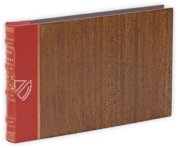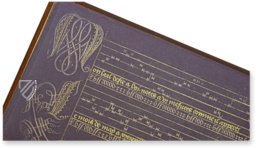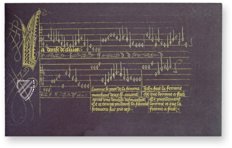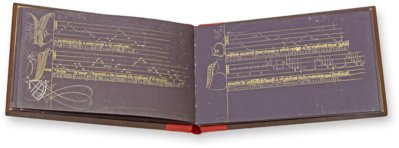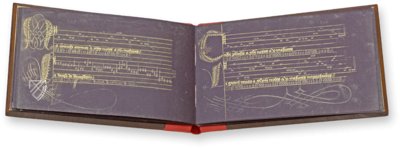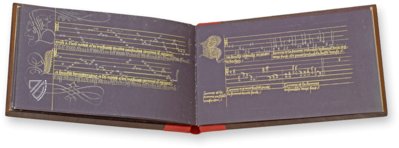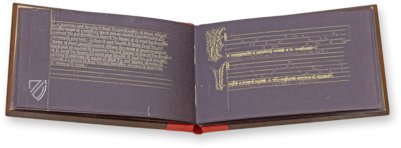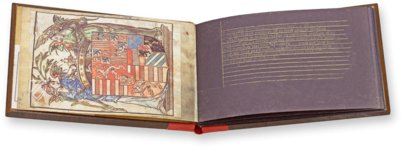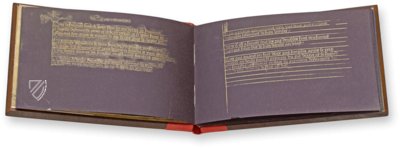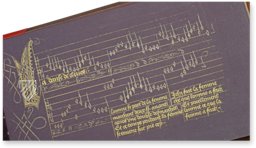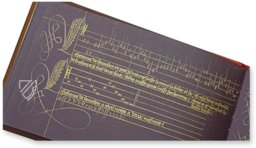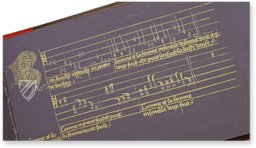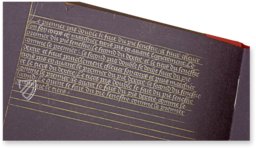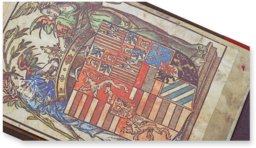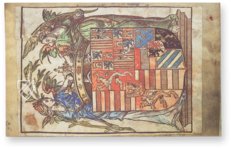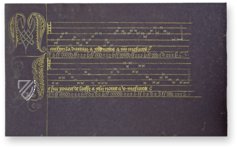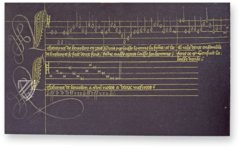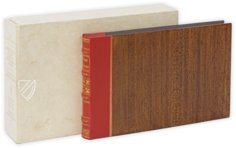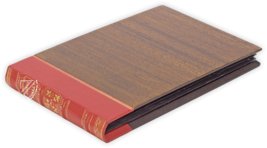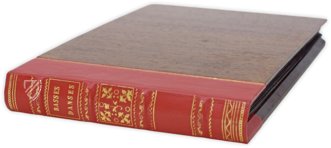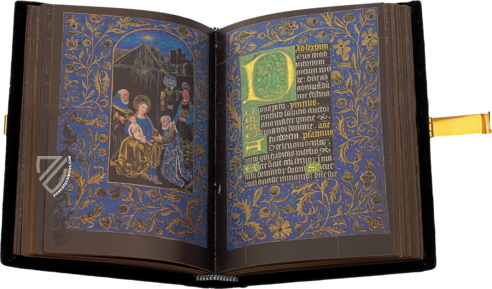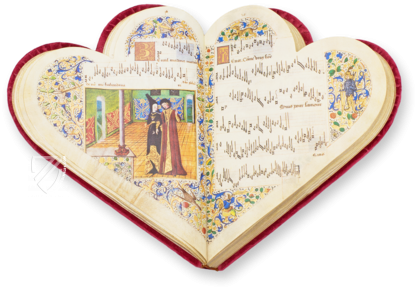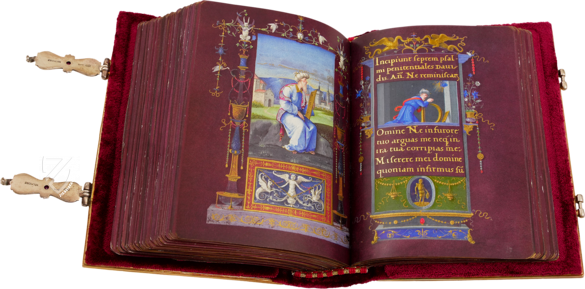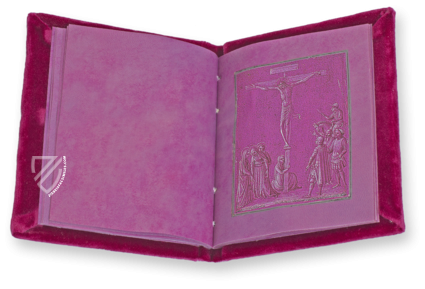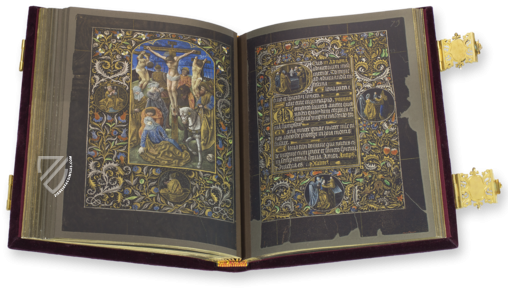Dancing Book of Margaret of Austria
(1,000€ - 3,000€)
As restrictions on music and dancing were relaxed by the Catholic Church in the course of the Middle Ages, dancing became more common and the dances more complex. Dancing became an essential part of court life, knowing the right dances was an indicator that one came from the right strata of society, that one belonged. Therefore, instructive books became popular as learning aids and reference works, especially for young nobles learning to be ladies and gentlemen. The Dancing Book of Margaret of Austria is an especially rare and beautiful example thereof from the 15th century. It is not only significant in terms of music and cultural history, but also a particularly rare and beautiful example, as it is one of only seven so-called "black manuscripts" that have survived to the present day. Its magnificent gold and silver notations and letters unfold an extraordinary aesthetic on the dark parchment.
Dance Booklet of Margaret of Austria
The Dancing Book of Margaret of Austria was created ca. 1470 as an aid for dancers of the "Basses Danses ", which were popular not only in Flanders. These floor dances without jumps were an important part of court life in late medieval Europe. This outstanding Flemish example on black parchment was named after the music-loving Margaret of Austria, daughter of Mary of Burgundy (1457–1482) and Emperor Maximilian I (1459–1519), in whose 1523 inventory it is first mentioned. It is a splendid demonstration that masterpieces of book art do not always have to be richly decorated with miniatures.
Music in Silver and Gold
After an impressive page showing several coats of arms, the booklet commences with a brief theoretical section listing 59 different dances. Each page bears a golden lineation on which the titles of the dances, together with texts, musical notes and step designations, are written in both gold and silver. Beautiful cadels adorn nearly all pages, and their vigorous interlace identifies the manuscript as a courtly masterpiece. It can be rightly assumed that the work had initially been in the possession of Maria of Burgundy, the wife of Emperor Maximilian I, before she bequeathed it to her daughter Margaret, later Governor General of the Netherlands. Her successor Maria of Hungary is also identified by an engraved ex-libris as the owner of the dance booklet, which later passed into the hands of King Philip II of Spain. It remained in the Burgundian library of the Habsburg dynasty until it was transferred to the Bibliothèque Royale in Brussels.
A rare jewel
The Dancing Book of Margaret of Austria owes its singularity not only to its musical contents and its significance for European cultural history, but also to its masterly executed calligraphic decoration in gold and silver and, last but not least, to its unusual writing material. The landscape-format work is one of only seven surviving manuscripts written on black-dyed parchment. Outstanding in the history of book production, this gem impressively demonstrates the luxury of the Burgundian court – and all without miniatures.
Enchanting Golden Calligraphy on Black Parchment
The dark parchment creates an extraordinary aesthetic and makes the gold and silver used particularly shine. Especially the magnificent cadels are a real feast for the eyes. Created in gold ink, the intersecting and paralleling shafts and arches create a vibrant calligraphic interlace in which the letters almost artfully dissolve. However, the special charm resulting from this contrast is also a reason for the extremely fragile condition of the original manuscript, which makes the facsimile edition all the more valuable for the preservation of this small masterpiece.
Codicology
- Alternative Titles
- Les basses danses de Marguerite d'Autriche
Tanzbüchlein der Margarete von Österreich - Size / Format
- 56 pages / 12.8 × 21.0 cm
- Origin
- Belgium
- Date
- Between 1475 und 1501
- Epochs
- Style
- Genre
- Language
- Illustrations
- Notations, texts, and initials shine in gold and silver on black vellum; the calligraphic initials are artistically executed as cadels; the copperplate ex-libris with the coat of arms of Mary of Hungary is a later addition
- Content
- Theoretical introduction to the courtly basse danse, musical notation and choreographic instructions for 58 dances of this type
- Patron
- Mary of Burgundy (1457–82), wife of Emperor Maximilian I
- Previous Owners
- Margaret of Austria (1480–1530)
Mary of Hungary (1505–58)
King Philip II of Spain (1527–98)
House of Hapsburg
Dancing Book of Margaret of Austria
Arms of Mary of Hungary
The coat of arms found at the beginning of the manuscript was not added until decades after it was created and belongs to Queen Mary of Hungary (1505–58), who later became governor of the Habsburg Netherlands. Her husband King Louis II of Hungary is represented on the left side while the noble inheritance of her parents is seen on the right including the distinctive castles of Castile, the fleur-de-lys and azure/gold bands of Burgundy, the red crowned lion of Limburg, and the gold lion of Brabant.
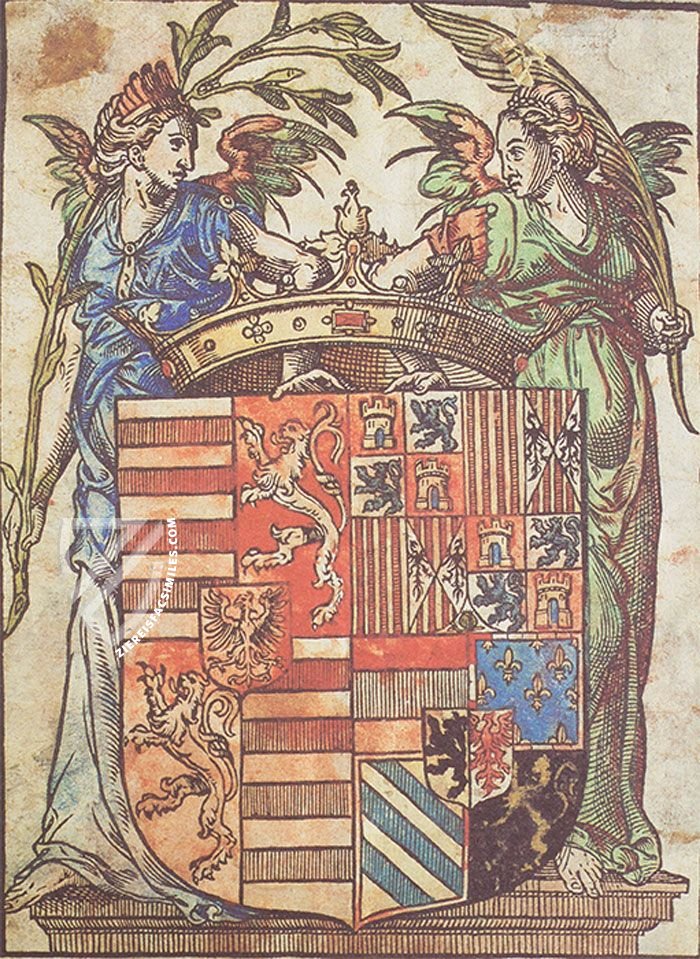
Dancing Book of Margaret of Austria
La Danse de Cleves
Introduced by a gorgeous large golden “L” initial, La Danse de Cleves is an irregular “basse danse” of the type that was extremely popular among the European nobility during the 15th and 16th centuries. Unlike most of the other dances in the manuscript, it is not strictly processional and is accompanied by a complex rhythm.
The black page, created by soaking the parchment in an iron-copper solution, creates the perfect background for the gold and silver ink, the latter of which appears almost white. This is one of only three “black” manuscripts to survive intact as a codex because the same process that gives the parchment its rich black color also corroded it. Today, the manuscript is extremely fragile, which necessitated the creation of a facsimile.
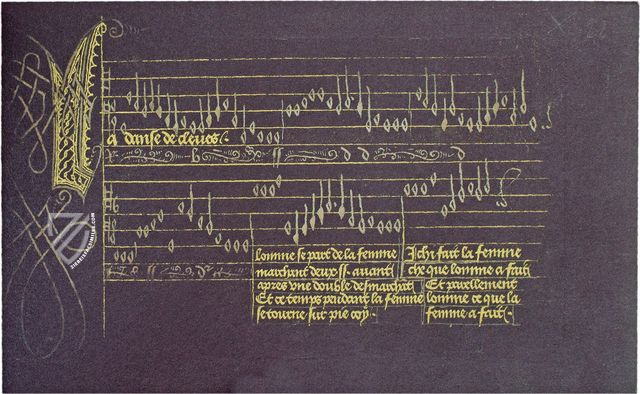
#1 Tanzbüchlein der Margarete von Österreich
Language: German
(1,000€ - 3,000€)
- Treatises / Secular Books
- Apocalypses / Beatus
- Astronomy / Astrology
- Bestiaries
- Bibles / Gospels
- Chronicles / History / Law
- Geography / Maps
- Saints' Lives
- Islam / Oriental
- Judaism / Hebrew
- Single Leaf Collections
- Leonardo da Vinci
- Literature / Poetry
- Liturgical Manuscripts
- Medicine / Botany / Alchemy
- Music
- Mythology / Prophecies
- Psalters
- Other Religious Books
- Games / Hunting
- Private Devotion Books
- Other Genres
- Afghanistan
- Armenia
- Austria
- Belgium
- Belize
- Bosnia and Herzegovina
- China
- Colombia
- Costa Rica
- Croatia
- Cyprus
- Czech Republic
- Denmark
- Egypt
- El Salvador
- Ethiopia
- France
- Germany
- Greece
- Guatemala
- Honduras
- Hungary
- India
- Iran
- Iraq
- Israel
- Italy
- Japan
- Jordan
- Kazakhstan
- Kyrgyzstan
- Lebanon
- Liechtenstein
- Luxembourg
- Mexico
- Morocco
- Netherlands
- Palestine
- Panama
- Peru
- Poland
- Portugal
- Romania
- Russia
- Serbia
- Spain
- Sri Lanka
- Sweden
- Switzerland
- Syria
- Tajikistan
- Turkey
- Turkmenistan
- Ukraine
- United Kingdom
- United States
- Uzbekistan
- Vatican City
- A. Oosthoek, van Holkema & Warendorf
- Aboca Museum
- Ajuntament de Valencia
- Akademie Verlag
- Akademische Druck- u. Verlagsanstalt (ADEVA)
- Aldo Ausilio Editore - Bottega d’Erasmo
- Alecto Historical Editions
- Alkuin Verlag
- Almqvist & Wiksell
- Amilcare Pizzi
- Andreas & Andreas Verlagsbuchhandlung
- Archa 90
- Archiv Verlag
- Archivi Edizioni
- Arnold Verlag
- ARS
- Ars Magna
- ArtCodex
- AyN Ediciones
- Azimuth Editions
- Badenia Verlag
- Bärenreiter-Verlag
- Belser Verlag
- Belser Verlag / WK Wertkontor
- Benziger Verlag
- Bernardinum Wydawnictwo
- BiblioGemma
- Biblioteca Apostolica Vaticana (Vaticanstadt, Vaticanstadt)
- Bibliotheca Palatina Faksimile Verlag
- Bibliotheca Rara
- Boydell & Brewer
- Bramante Edizioni
- Bredius Genootschap
- Brepols Publishers
- British Library
- C. Weckesser
- Caixa Catalunya
- Canesi
- CAPSA, Ars Scriptoria
- Caratzas Brothers, Publishers
- Carus Verlag
- Casamassima Libri
- Centrum Cartographie Verlag GmbH
- Chavane Verlag
- Christian Brandstätter Verlag
- Circulo Cientifico
- Club Bibliófilo Versol
- Club du Livre
- CM Editores
- Collegium Graphicum
- Collezione Apocrifa Da Vinci
- Comissão Nacional para as Comemorações dos Descobrimentos Portugueses
- Coron Verlag
- Corvina
- CTHS
- D. S. Brewer
- Damon
- De Agostini/UTET
- De Nederlandsche Boekhandel
- De Schutter
- Deuschle & Stemmle
- Deutscher Verlag für Kunstwissenschaft
- DIAMM
- Droz
- E. Schreiber Graphische Kunstanstalten
- Ediciones Boreal
- Ediciones Grial
- Ediclube
- Edições Inapa
- Edilan
- Editalia
- Edition Deuschle
- Edition Georg Popp
- Edition Leipzig
- Edition Libri Illustri
- Editiones Reales Sitios S. L.
- Éditions de l'Oiseau Lyre
- Editions Medicina Rara
- Editorial Casariego
- Editorial Mintzoa
- Editrice Antenore
- Editrice Velar
- Edizioni Edison
- Egeria, S.L.
- Eikon Editores
- Electa
- Emery Walker Limited
- Enciclopèdia Catalana
- Eos-Verlag
- Ephesus Publishing
- Ernst Battenberg
- Eugrammia Press
- Extraordinary Editions
- Fackelverlag
- Facsimila Art & Edition
- Facsimile Editions Ltd.
- Facsimilia Art & Edition Ebert KG
- Faksimile Verlag
- Feuermann Verlag
- Folger Shakespeare Library
- Franco Cosimo Panini Editore
- Friedrich Wittig Verlag
- Fundación Hullera Vasco-Leonesa
- G. Braziller
- Gabriele Mazzotta Editore
- Gebr. Mann Verlag
- Gesellschaft für graphische Industrie
- Getty Research Institute
- Giovanni Domenico de Rossi
- Giunti Editore
- Graffiti
- Grafica European Center of Fine Arts
- Guido Pressler
- Guillermo Blazquez
- Gustav Kiepenheuer
- H. N. Abrams
- Harrassowitz
- Harvard University Press
- Helikon
- Hendrickson Publishers
- Henning Oppermann
- Herder Verlag
- Hes & De Graaf Publishers
- Hoepli
- Holbein-Verlag
- Houghton Library
- Hugo Schmidt Verlag
- Idion Verlag
- Il Bulino, edizioni d'arte
- ILte
- Imago
- Insel Verlag
- Insel-Verlag Anton Kippenberger
- Instituto de Estudios Altoaragoneses
- Instituto Nacional de Antropología e Historia
- Introligatornia Budnik Jerzy
- Istituto dell'Enciclopedia Italiana - Treccani
- Istituto Ellenico di Studi Bizantini e Postbizantini
- Istituto Geografico De Agostini
- Istituto Poligrafico e Zecca dello Stato
- Italarte Art Establishments
- Jan Thorbecke Verlag
- Johnson Reprint Corporation
- Josef Stocker
- Josef Stocker-Schmid
- Jugoslavija
- Karl W. Hiersemann
- Kasper Straube
- Kaydeda Ediciones
- Kindler Verlag / Coron Verlag
- Kodansha International Ltd.
- Konrad Kölbl Verlag
- Kurt Wolff Verlag
- La Liberia dello Stato
- La Linea Editrice
- La Meta Editore
- Lambert Schneider
- Landeskreditbank Baden-Württemberg
- Leo S. Olschki
- Les Incunables
- Liber Artis
- Library of Congress
- Libreria Musicale Italiana
- Lichtdruck
- Lito Immagine Editore
- Lumen Artis
- Lund Humphries
- M. Moleiro Editor
- Maison des Sciences de l'homme et de la société de Poitiers
- Manuscriptum
- Martinus Nijhoff
- Maruzen-Yushodo Co. Ltd.
- MASA
- Massada Publishers
- McGraw-Hill
- Metropolitan Museum of Art
- Militos
- Millennium Liber
- Müller & Schindler
- Nahar - Stavit
- Nahar and Steimatzky
- National Library of Wales
- Neri Pozza
- Nova Charta
- Oceanum Verlag
- Odeon
- Orbis Mediaevalis
- Orbis Pictus
- Österreichische Staatsdruckerei
- Oxford University Press
- Pageant Books
- Parzellers Buchverlag
- Patrimonio Ediciones
- Pattloch Verlag
- PIAF
- Pieper Verlag
- Plon-Nourrit et cie
- Poligrafiche Bolis
- Presses Universitaires de Strasbourg
- Prestel Verlag
- Princeton University Press
- Prisma Verlag
- Priuli & Verlucca, editori
- Pro Sport Verlag
- Propyläen Verlag
- Pytheas Books
- Quaternio Verlag Luzern
- Reales Sitios
- Recht-Verlag
- Reichert Verlag
- Reichsdruckerei
- Reprint Verlag
- Riehn & Reusch
- Roberto Vattori Editore
- Rosenkilde and Bagger
- Roxburghe Club
- Salerno Editrice
- Saltellus Press
- Sandoz
- Sarajevo Svjetlost
- Schöck ArtPrint Kft.
- Schulsinger Brothers
- Scolar Press
- Scrinium
- Scripta Maneant
- Scriptorium
- Shazar
- Siloé, arte y bibliofilia
- SISMEL - Edizioni del Galluzzo
- Sociedad Mexicana de Antropología
- Société des Bibliophiles & Iconophiles de Belgique
- Soncin Publishing
- Sorli Ediciones
- Stainer and Bell
- Studer
- Styria Verlag
- Sumptibus Pragopress
- Szegedi Tudomànyegyetem
- Taberna Libraria
- Tarshish Books
- Taschen
- Tempus Libri
- Testimonio Compañía Editorial
- Thames and Hudson
- The Clear Vue Publishing Partnership Limited
- The Facsimile Codex
- The Folio Society
- The Marquess of Normanby
- The Richard III and Yorkist History Trust
- Tip.Le.Co
- TouchArt
- TREC Publishing House
- TRI Publishing Co.
- Trident Editore
- Tuliba Collection
- Typis Regiae Officinae Polygraphicae
- Union Verlag Berlin
- Universidad de Granada
- University of California Press
- University of Chicago Press
- Urs Graf
- Vallecchi
- Van Wijnen
- VCH, Acta Humaniora
- VDI Verlag
- VEB Deutscher Verlag für Musik
- Verlag Anton Pustet / Andreas Verlag
- Verlag Bibliophile Drucke Josef Stocker
- Verlag der Münchner Drucke
- Verlag für Regionalgeschichte
- Verlag Styria
- Vicent Garcia Editores
- W. Turnowski Ltd.
- W. Turnowsky
- Waanders Printers
- Wiener Mechitharisten-Congregation (Wien, Österreich)
- Wissenschaftliche Buchgesellschaft
- Wissenschaftliche Verlagsgesellschaft
- Wydawnictwo Dolnoslaskie
- Xuntanza Editorial
- Zakład Narodowy
- Zollikofer AG

